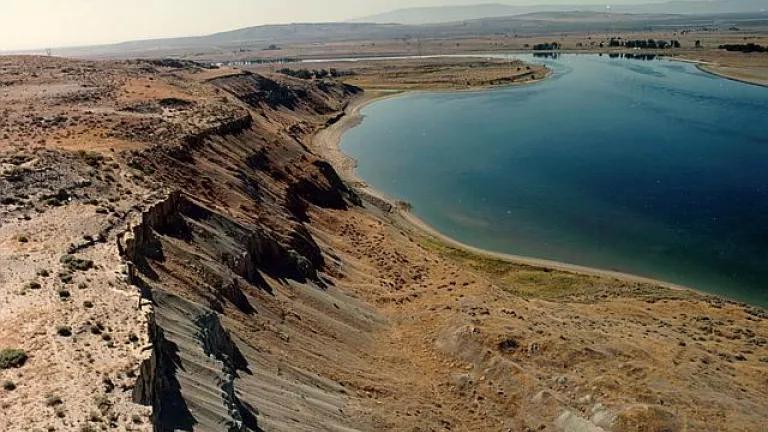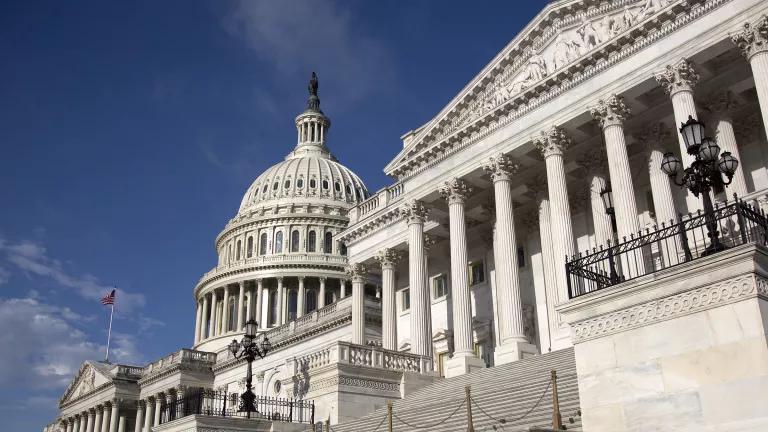2021 – A Year of Nuclear Policy Starts and Stops
The year was marked by one historic development and many administrative disappointments in nuclear policy.

Part of NRDC's Year-End Series Reviewing 2021 Climate & Clean Energy Developments
This year Congress put forward a new idea addressing nuclear waste, a long, long overdue step to ending the quagmire on this issue. For nuclear policy, this was surely the highlight of the year.
Senator Ed Markey and Rep. Mike Levin introduced the Nuclear Waste Task Force Bill, which would establish a task force of federal agencies, states, tribes, and others to analyze the “implications of amending the Atomic Energy Act of 1954 to remove exemptions from environmental laws for spent nuclear fuel and high-level radioactive waste to allow for consent-based siting of geologic repositories.” This is just the change that NRDC has advocated for years. Efforts to examine consent-based siting for nuclear waste storage also restarted at the Department of Energy this year, but it focused only on interim measures and didn’t press the issue of what “consent” really means—as opposed to the Congressional Task Force bill, which by its own terms will elicit just that answer. We will be responding to DOE’s efforts in 2022, but our hopes remain in an enacted Task Force legislation.
Of course, most of 2021 Congress spent working on the Bipartisan Infrastructure Deal and the Build Back Better Act. While both bills include vital provisions, including historic climate investments, they also provide significant financial support for old and aging nuclear reactors and for uncertain proposed nuclear technology.
As compared to the developments before Congress, before the federal agencies in charge of nuclear policy, 2021 has mostly been a year of impatient waiting for actions that haven’t come.
We welcomed the addition of Christopher Hanson as Chairman to the Nuclear Regulatory Commission. Yet the year closes with two of the five Commission seats empty. Hopefully 2022 will bring a paired nomination to the Commission—especially because NRC will address major topics in the new year, including continuing its environmental justice assessment and finalizing rules for advanced nuclear reactor licensing and reactor decommissioning. We were disappointed with the agency’s draft decommissioning rule and will be making significant efforts to help them strengthen the requirements in the final rule. It’s vital NRC get this rule right considering the upcoming wave of closing nuclear reactors—which as we’ve seen from New York’s Indian Point and California’s Diablo Canyon, is happening for both safety and cost-savings reasons and not interfering with ambitious climate plans.
Similarly, while certain Department of Energy positions have been filled, one major role remains empty. The Assistant Secretary of Energy for Environmental Management (aka EM1) runs the largest environmental cleanup program in the world—that of the contamination resulting from the U.S.’s nuclear weapons production and government-sponsored nuclear energy research. The failure to fill this position leaves progress on addressing weapon’s nuclear waste somewhat in limbo. Instead, in 2021 DOE seemingly stuck with Trump administration policies like attempting to “reclassify” high level radioactive waste and thereby avoid meaningful cleanup. DOE also advanced the wasteful proposal for a “uranium reserve.” We hope that in 2022 DOE reverses course on these policies.
The EPA also failed to make progress—specifically in developing protections against the impacts of uranium mining. In 2015, after nearly a decade of work, the EPA developed and proposed the first set of meaningful environmental protections for in-situ leach (ISL) uranium recovery. But the clock ran out on the Obama administration before the EPA could finalize the rule, and in October 2018 the Trump Administration withdrew the draft rule. The Biden EPA has been reviewing this action all year with an evident lack of urgency. Maybe in 2022 EPA will finally take action on uranium mining contamination and protect western groundwater.
In global nuclear energy news, the World Nuclear Industry Status Report again produced a roundup of the status and trends of the international nuclear power industry. In addition to a worldwide overview showing delayed constructions and aging fleets, the 2021 Report includes sections on nuclear power and climate change resilience, nuclear power and criminal energy, and reviews of 10-years after Fukushima and 35-years after Chernobyl.
On the weapons side, nuclear weapons remain an overwhelming problem for humanity. While the year included such good news as the extension of the New START treaty, nascent dialogue between the U.S. and China on nuclear arms control, and the resumption of talks with Iran, a new arms race still seems to be upon us—the U.S. projects to spend $1.2 trillion over the next 30 years on its nuclear forces, Russia stated it may deploy intermediate-range nuclear missiles in Europe in response to perceived NATO intentions, China may be on a course to build up its nuclear arsenal three-fold to 1,000 weapons by 2030, Iran’s uranium-enrichment efforts continue to expand, and there was no movement on North Korean denuclearization. In 2022 the United States must work to repair the architecture of nuclear risk reduction and more ably address the threat of nuclear war alongside environmental, public health, and political crises.
This past year was marked by one historic development and many administrative disappointments. Next year must bring a new urgency to nuclear policy priorities and a focus on transformative change with respect to nuclear waste, safety, and uranium recovery.



